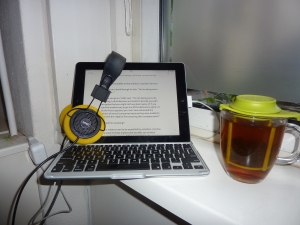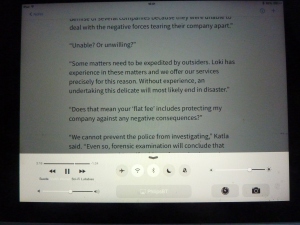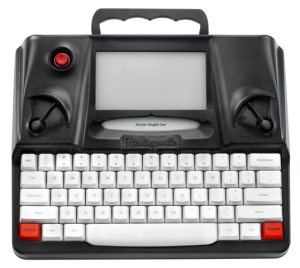Distraction-Free Writing: No Need To Re-Invent The Wheel…
Posted: December 11, 2014 Filed under: Uncategorized 2 CommentsWith the Hemingwrite, young enterpreneurs are trying to give a new spin to an old concept: How To Increase Writing Productivity By Removing Distractions. But, before you back their KickStarter campaign, see how they are reinventing what is already available…
A friend showed me the Hemingwrite kickstarter campaign, asking me if the Hemingwrite was something for me to increase my productivity. As I explained to him, the Hemingwrite concept is hardly new, and expensive to boot. Since commenting on the kickstarter is only available to backers (and I don’t plan to back the Hemingwrite), I will post my response here.
First off, what is the Hemingwrite?
According to the Hemingwrite website:
The Hemingwrite is a minimalist digital typewriter for distraction free writing composition. It combines the simplicity of a typewriter with modern technology like an electronic paper screen and cloud backups to create the best possible writing experience. It is designed to do one thing only but do it exceptionally well. Since there is no email, Facebook, browser, or menus, you are able to stay in your creative groove and finally get your writing done!
And it looks like this:
I think it’s lovely, I really do, but it’s not as original as it pretends to be.
The Hemingwrite seems to borrow heavily from:
The NEO Alphasmart
This machine was discussed as a distraction-free writing tool on several author-centric fora:
To quote Wikipedia:
The AlphaSmart is a keyboarding device that enables a person to work on the go, much like a laptop computer, but it is strictly for word processing, as it functions essentially like a simple digital typewriter. The Dana (a newer device made by AlphaSmart, Inc.) is an exception, as this device can also run Palm OS applications. Since the AlphaSmart, Dana, and NEO are specialized for limited purposes, they are generally much cheaper than a standard laptop computer. All of these devices are meant to be plugged into an ADB, PS/2, or USB port for transferring the written text into a computer’s word processing document for further editing (such as indentation and font preference) or printing if so desired.
The AlphaSmart saves every keystroke directly to the machine’s RAM, which is maintained by a battery backup even when powered down. AlphaSmarts can transfer data either by a special program that communicates with the AlphaSmart or by the simpler method of transmitting the keystrokes of the written text as if it were the computer’s keyboard. When not transferring text, the Alphasmart can be used as a standard keyboard.
AlphaSmarts are very popular in schools for their affordability and durability. Elementary schools and high schools use them; they are particularly popular among special education departments for use by students with graphomotor challenges.
The machines have also developed a type of cult following among journalists and writers, who find them easy to carry and appreciate the full-size keyboard and long battery life.
Sounds deceptively similar to the Hemingwrite, doesn’t it? Sadly:
The AlphaSmart is a brand of portable, battery powered, word-processing keyboards manufactured by NEO Direct, Inc. (formerly AlphaSmart, Inc.), currently owned by Renaissance Learning, Inc. The models were discontinued by the company in late September 2013, although it still offers support and software to existing users.[1]
However, the Alphasmart was not the first one to think of this, because in 1983, this machine was introduced:
The TRS-80 Model 100:
Let’s quote Wikipedia again:
The TRS-80 Model 100 is a portable computer introduced in 1983. It was one of the first notebook-style computers, featuring a keyboard and liquid crystal display, in a battery-powered package roughly the size and shape of a notepad or large book.
It was made by Kyocera, and originally sold in Japan as the Kyotronic 85. Although a slow seller for Kyocera, the rights to the machine were purchased by Tandy Corporation. The computer was sold through Radio Shack stores in the United States and Canada and affiliated dealers in other countries. It became one of the company’s most popular models, with over 6,000,000 units sold worldwide. The Olivetti M-10 and the NEC PC-8201 and PC-8300 were also built on the same Kyocera platform, with some design and hardware differences. It was originally marketed as a Micro Executive Work Station (MEWS), although the term did not catch on and was eventually dropped.
Now, while the TRS might be hard to find (and difficult to use), anyone interested in the Neo Alphasmart can just find them on eBay for approximately 30$. In short, before you commit to the fancy new Hemingwrite, consider the alternatives.
So what do I use?
I admit that while I use Scrivener on my MacBook Pro to edit my work, I do the bulk on my writing on another machine.
This machine:

But-but, that is an iPad?
Why, yes, it is. It’s an iPad 2, with a ZAGGkeys ProPlus bluetooth keyboard. You see, Scrivener can work together with a free app called SimpleNote. And, talk about distraction-free writing:

Credits: M.V. Halm
That’s right. No formatting, not even bold/italic/underline. Nothing but raw text.
However, once I’m home, I can sync Scrivener with SimpleNote and the changes I made will be seamlessly integrated in my Scrivener document, where I can turn the double-hyphen into an em-dash, make passages bold or italic, etcetera.
But-but, it’s an IPAD. It has apps and stuff! DISTRACTIONS!
Yes, I know. However, most of the distraction you get from apps is in their connectivity. And that is the key. When I’m using the iPad for writing, I swipe the bottom and there you’ll see a menu.

To the left is the iTunes player*, but in the middle are five buttons: Airplane mode, Wifi, Bluetooth, Do Not Disturb, and Mute. Switch off the WiFi and you’ll be disconnected from the internet. No emails, no facebook updates, no tweets. Hit Do Not Disturb and you won’t get any Calendar updates.
The only thing that is really required is the self-discipline to switch off the wireless internet connection.
(*As you can see from my specially modified SR60 ‘Ultralight’ headphone, I also use the iPad for music. Music and the headphone help to isolate me from other people when I’m writing in public, which also increases my productivity in a way none of the other machines can provide. So if you use music when you write, realise that with the Hemingwrite or the Alphasmart, you’ll still have to bring a separate Digital Audio Player (DAP).)
If you think this article might be informative for other people, please use the social media buttons underneath to share this article. Thank you.




I have to say that the Hemingwrite (Freewrite) is attractive, but the price is ridiculous. Right now I’m using a NEO, typewriters and a paper journal.You got my curiosity up with SimpleNote. Have you played around with the IOS Notes app or Google docs (can be used offline)?
LikeLiked by 1 person
No, I’m working mostly on manual typewriters.
LikeLike